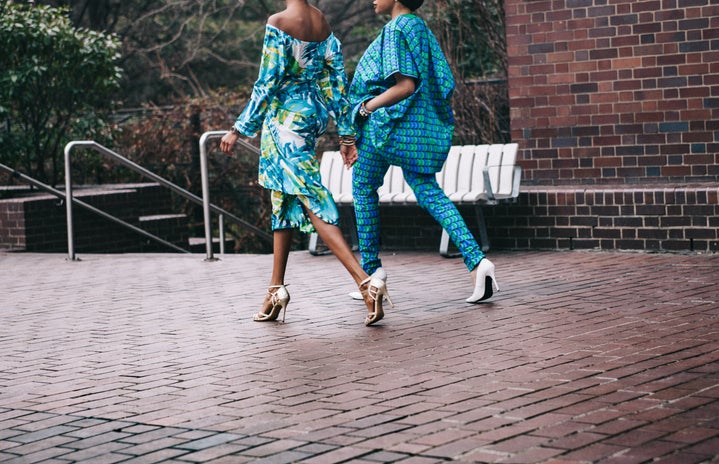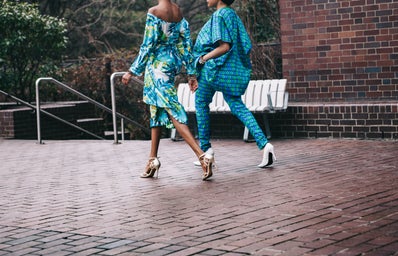Loyola’s Vietnam Center utilizes fall break to take students to central and northern Vietnam. We had the opportunity to explore areas for ourselves to get a feel for Vietnam, outside of Ho Chi Minh City. Our first stop was Hue, central Vietnam.
Hue
We landed shortly after noon, and our first visit was the Citadel.
The Citadel is where the Nguyễn Dynasty, Vietnam’s last dynasty consisting of 13 kings, lived and “ruled.” I put “ruled” in quotes because these 13 kings were essentially puppets to the French Colonial regime. The buildings were beautiful with intricate paintings and Chinese characters and poems. We even saw the king’s throne, which looked simple but was actually very ornate as well. It was made from wood and gold leaf.
Next we visited Thien Mu pagoda. Legend has it that an old woman appeared on this mountain and told the people to build a pagoda, and so they did. It was not as flashy as the other pagodas I have visited, but still beautiful in its own way. This was the pagoda where the monk, Thich Quang Duc, burned himself came from. The photo of his self-immolation became a very famous photo from the Vietnam War. He was protesting the anti-Buddhist regime of Diem in Southern Vietnam. After his self-immolation, they carried the car he drove back to the pagoda.
We then got to look upon the gorgeous perfume river and take a tourist boat back to our hotel. That night, we went out for bún bò Huế, a beef noodle soup popular to the region. We decided to walk through the backpacker street and landed upon a very chill bar and restaurant for late-night happy hour! This led us to our next destination where a dance floor was provided to shake off the happy hour. It was one of the most fun nights of my life; good friends, good food and drinks, good music and good fun.
We awoke early the next morning to visit the Tomb of Emperor Minh Mang. It was more like an entire park. The experience was tremendously interesting but also harrowing. We learned about the funeral processions of Nguyễn kings (treasure, servants and wives were buried with them!) and that the actual location of the dead king’s body is unknown; they kept the location secret within the tomb so thieves could not steal the treasure.
Next came the journey to Hỏi An, with a stop at the ruins of an old colonial military post to view the city of Đã nâng. The view was incredible overlooking the beach surrounded by mountains. Some of us climbed on the ruins of old buildings to get a good view, and a good picture!
Hồi An
Hoi An is absolutely gorgeous. It is called the “Lantern City,” and we saw why as soon as we walked through the night market on the riverside. Even as the sun went down, the lights eminating from all the lanterns continued to glow on the water. It was colorful and lively.
We ate the famous dish cậu lâu (brown noodle). Then we wandered around the city. It is probably the most touristy city I have been to, and I later learned that tourism is really what drives the economy of Hồi An. The market was absolutely beautiful. Lanterns everywhere. It was a gorgeous night.
We saw some Cham ruins the next morning which were absolutely amazing. The Champa empire was primarily Hindu, with some foundations of Confucianism as well. It was boiling hot and my face was dripping, but my eyes were wide open. The primary god of worship at these temple ruins was the Hindu god Shiva, represented as a straight, erect figure. It is meant to mean power and strength.
We later rented bicycles and rode three kilometers to a nearby pottery village. In this communal area most houses doubled as shops where the people opened their homes to complete strangers for the sake of making a living. It was beautiful and humbling to see.
We stopped along our bike ride as we passed a famous banh mi shop. Anthony Bordaine had apparently claimed it as “the best banh mi in Vietnam.” Short answer: it was amazing. Something about Hoi An produced amazing sandwiches, because the next morning I tried another famous banh mi shop that was also delicious.
That night, we went back to the night market; back to the beautiful walkway overlooking a river covered with the glare from thousands of lanterns. We ate mango cakes and ordered cheap cocktails. My friend Paulina and I walked and explored and talked, and eventually we found our way back to the hotel where we met up with more friends and did much of the same. My body was exhausted that night. Thankfully, we had the opportunity to sleep in the next day before we flew to Hanoi.
Hanoi
Entering Hanoi was almost like culture shock; it was so similar to Saigon and yet so different. The streets were less crowded, the city a bit more spacious, and the old buildings were much better preserved. I tried Hanoi phổ for the first time and it was absolutely delicious (they claim this is where Vietnam’s famous noodle soup started).
The next morning we awoke early for a very long day of museums and educational sight-seeing. The first stop was the mausoleum of Ho Chi Minh. The dress code and camera/phone code was very strict and we were made to walk single- file in the heavily guarded structure.
Ho Chi Minh’s body was preserved and now on display in a glass case. We were allowed one lap of the room to take it all in; it was truly harrowing and mind-boggling. The line outside grew as the afternoon went on, outside the building was a plethora of tourists taking photos.
We then saw his vestige with various homes,bunkers and a one-villa pagoda. One thing that stuck out to me was the karma boards on the walls depicting images of humanly action, then the subsequent consequence.
Next we visited the Vietnam Museum of Ethnology. The museum taught about the 53 ethnic groups in Vietnam (where the Viet or Kinh are dominant).
Our next stop was the Temple of Literature. This is the trademark place for Confucian Scholars (reword more eloquently). It was fascinating to learn how Confucianism became a state religion, and how it enforces feudal, orderly society. In order to become a Confucian scholar, students must undergo strenuous studying in order to pass the difficult examinations. With my personal opinions about Confucianism aside, the temple was beautiful.
Next was the Women’s Museum, which was a great representation of Vietnamese women and their roles in society.
(This picture is a collage of women who have lost sons and/or husbands to war. They are the grieving women of Vietnam who are finally paid their overdue homage.)
That evening, we went out for Bia Hoi Ha Noi, an exceptionally cheap draft beer famous to Hanoi.
Our final stop on the official Loyola-sponsored excursion was Hoa Lo prison. French colonials constricted the building and used it to imprison anti-colonialists and Communists. Then, after the French defeat in 1954, the North Vietnamese used the prison to hold American prisoners of war, including John McCain. Seeing the prison itself was very interesting; at one point I even locked myself into one of the death row cells to get a sense of dread and gloom these prisoners must have felt. It was also fascinating to see how the Vietnamese view what they call The American War. Throughout the exhibition, it stressed the war crimes of the Americans, and how well the American POWs were treated in prison. Honestly, it felt like propaganda. It was fascinating to see how two countries tell completely different stories of the war.
For lunch, I had a dish called bun cha at a famous restaurant where Barack Obama and Anthony Bourdain had an iconic meal.
You haven’t been to Hanoi unless you make a stop for egg coffee. This beverage includes Vietnamese espresso with a custard-like cream made from whipped eggs and condensed milk. I could help myself and ordered two!
Ha Long Bay
Our Loyola-sponsored excursion was officially over that Wednesday, however we had the option to stay up north until Sunday. My roommate and I decided to take a girls trip for our northern extension!
We got an AirBnB in Hanoi, and the very next morning got picked up in a small bus for a day-long tour of the world-famous Ha Long Bay. Bill Hayton explains in Vietnam: Rising Dragon:
“Ha Long Bay is truly spectacular. More than 2,000 limestone towers erupt from the sea. From afar they look like the back of the descending dragon which gives the Bay its name. Each one is its own little nature reserve, the steep cliffs and flat summits providing home for clinging greenery and intrepid wildlife.”
We made three stops on our tour: one to an enormous mountain cave, the second to a small grotto where we could kayak and view the wildlife, and a third which included the chance to hike up one of the limestone mountains. Between each stop, Sam and I sat entranced in the view. It was reflective and utterly stunning.
Ninh Binh
Friday morning, we took a train to the tranquil province of Ninh Binh, up in the northern mountains for a relaxing getaway. When we found our homestay, our host, Yen, sat down with us and pulled out a map. Her English was great and she circled all the places we should visit in Ninh Binh, including their distance from the homestay and their cost. She highly recommended the boat tour through Trang An.
The tour lasted three hours. We had a nice Vietnamese woman rowing a boat through Trang An, which also included rowing in caves and grottos – often treacherous for a little rowboat! The experience was incredible; the views were breathtaking. Trang An is a stream that goes through rice paddies, surrounded by the same limestone structures found in Ha Long Bay. Considering it was rainy season when I visited, the rice paddies were mostly flooded.
Ninh Binh is famous for its goat meat, so we got goat pizza that day for lunch. After, we biked to a famous mountain of Ninh Binh called Hang Mua, or the Mua Caves.
It was after this wonderful hike up the beautiful limestone structure, and rock climbing onto the famous Laying Dragon statue at the top, when I was swarmed with mosquitoes. My skin had a terrible reaction to the plethora of bites. Luckily, we visited an herbal garden the next morning.
We found a woman on AirBnB named Ly who offered a tour of her family’s herb garden and an herbal bath at a nearby spa. It took up the entire morning and was not only informative but such a cool experience!
(Ly holding honeysuckle from her garden)
Our final major excursion on this trip up north was to Tam Coc, Ninh Binh. Much like Halong Bay and Trang An, this natural phenomenon was surrounded by mountainous limestone structures and flooded rice paddies (considering we are smack dab in the middle of the rainy season). As the rain fell, we took another boat ride through Tam Coc.
It gave me time to reflect on the entire experience up north. In just over a week, I was able to see so much more of a country I have been experiencing and learning about, but I realized I had only scratched the surface.



